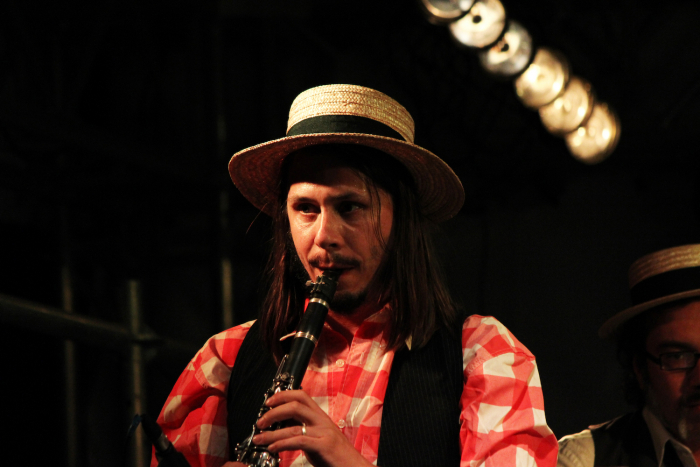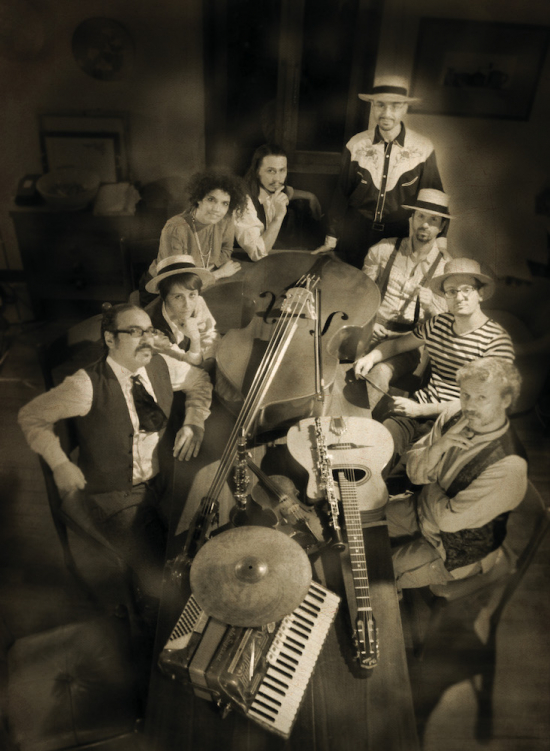Enrico Gabrielli is one of the most brilliant and eclectic Italian musicians of our times. Born in 1976, he pursued an academic education: after completing a degree in clarinet performance, he turned to composition studies with, among others, Salvatore Sciarrino and Alessandro Solbiati; he performed several times and featured in various recordings of contemporary music.
In 2002 he abandoned the classical music and started to research a pioneering approach to composition, which lead him to explore the rock sounds. During the next 13 years he played with Mariposa (10 records) and joined Afterhours, Calibro 35, The Winstons and PJ Harvey’s band (to name a few), before dedicating himself to experimental music once again, through his personal project Der Maurer and the record label 19’40”.
He constantly tried to free the music from a pre-set context: rock music therefore entered the academic halls (for example during his project Esecutori di metallo su carta, when noise rock and math metal pieces were performed by a chamber orchestra) and the liscio folk music gained a place in the rock shrines, thanks to the orchestra Orchestrina di molto agevole.
In this last project musicians coming from the rock scene, as well as the underground one (Afterhours, Baustelle, Hobocombo…), interpreted the historical liscio pieces by Secondo Casadei, Carlo “Zaclèn” Brighi, Ferrero Rossi, Mario Cavallari, Giorgio D’Anzi and other composers of traditional dance music of the XX century.
We learn more about the Orchestrina in this interview.
“‘Simpatia. What is the simpatia?’
This is THE question with regards to liscio folk music of the Romagna region, especially the music of the master Secondo Casadei.
The concept of simpatia is linked to the idea of “making other strings vibrate in harmony” (as the sympathetic vibrations of the violin strings), but in Italian this term has multiple meanings, for example it can indicate a funny person, the act of enjoying each other’s company or getting on the same wave-length.
Liscio music complicates the matter even further. It is enough to consider that, hearing the first notes of liscio, children in the public get completely crazy, they let themselves go, they dance and it’s a dance made of tribal motions, it’s something ancestral. On the other hand, the adults in the public tend to refrain themselves most of the times.
Among all music genres, in the common thought liscio remains confined and chained to the idea of “aged” form of entertainment.
This is far from the truth. The liscio genre preserves a modern and incisive identity and, when it’s played with passion, it acquires a deep meaning rooted in popular culture. The father of liscio Secondo Casadei (Raoul Casadei’s uncle, the famous musician) and Carlo Brighi (1853 – 1915, considered the “founder” of liscio) should be included in the school programmes, as key figures of the Italian culture.
I have a classical background, I’ve studied in the Academy, then I turned to rock music for professional reasons (but also for my own pleasure). Five or six years ago I started listening, by chance, to a record of the orchestra La storia di Romagna. This group plays the traditional repertoire of Secondo Casadei, faithfully reproducing the original music scores. I remember that when I first listened to the record, I thought “That’s it!”: beneath a surface of “aged” aesthetic, the music and composition were extremely interesting and stimulating, they carried a deep meaning.
At first, before starting the Orchestrina di molto agevole, I tried to perform this primordial liscio pieces with my all-time group Mariposa: the result was an odd twist/pastiche which mixed together the electro, rock and psychedelia genres. This project, elusively called Liscio Gelli, never saw light, but marked the starting point for the Orchestrina.
In 2012, during a wedding party, the Orchestrina made its first appearance in front of a public composed mainly by musicians: I remember their looks of surprise and how they congratulated us and asked if we planned to record a liscio album.
The Orchestrina di molto agevole was defined by a precise musical choice: performing the classical repertoire of liscio as faithfully as possible to the original style of its golden age, which goes from the 40s to the 60s of the XX century. From these years on liscio started its decline, caused by the introduction of the electric instruments and, most of all, by the exaggerate and constant growth of its business. In the end the quintessential nature of liscio has been completely distorted.
You can find several interesting projects in the Romagna region, which reinterpret the historical liscio songs in a way similar to ours: for example ExtraLiscio, the Mr. Zombie Orchestra, the group of six elements Dal vangelo Secondo, the Simone Zanchini Quartet and the Casadei Secondo me project.
The Orchestrina di molto agevole’s repertoire is mainly composed by Secondo Casadei’s songs. His boundless artistic production, constantly maintaining a top-level quality and a strong identity, can be compared to the works of Antonio Vivaldi, who, between the XVII and XVIII centuries, wrote hundreds of scores, commissioned for the widest range of events and occasions; nonetheless each one of them was manufactured with deep care and characterised by his unique style.
We also recovered some pieces composed by less-known artists, such as Mario Cavallari (author of about 3000 songs; some of them reached success thanks to the voice of Nilla Pizzi), Giovanni D’Anzi (best known for O mia bela Madunina and Voglio vivere così). Furthermore, since our solo Francesca Ruiz Biliotti is an actual opera contralto, sometimes we verge on the operetta genre. This is the reason why in our second record called Agevolissima! vol.2, we would like to collaborate with Elio Pandolfi, one of the greatest Italian voice over actors and an expert of the operetta.
The core team of the Orchestrina counts 6/7 interchangeable artists. The main members are Rocco Marchi (guitarist for Mariposa and Hobocombo), Francesca Baccolini at the double bass (Hobocombo), Sebastiano de Gennaro (drummer for, among others, Daniele Silvestri, Baustelle, MEG), switching places with Dave Radice, Rodrigo D’Erasmo (violinist for Afterhours), Francesca Ruiz Biliotti (contralto), Gianni Chi and Guido Baldoni at the accordion. In our records and our shows, we frequently host: Vincenzo Vasi (singer and multi-instrumentalist, he collaborates with Vinicio Capossela and many others), Valeria Sturba, Serena Altavilla, Alessandro Fiori, and Roberto Dellera (bass player for Afterhours). In our first album Agevolissima! vol. 1, auto produced and released on vinyl, we tried to convey the feeling of an orchestra composed by a big number of people (the record features more than 20 guests), who gather to play liscio all together in simpatia, having fun and for pleasure. After all, the Orchestrina performed for the first time during a wedding, a celebration, therefore it should maintain the same joyful spirit throughout the years.
At the beginning, we looked for locations that contrasted with the liscio atmosphere, for example rock clubs. During these shows, we witnessed an intriguing cultural clash: in the wildest locations the public listened closely as if we were playing classical music, while when we brought liscio in smaller clubs, in the balere, in the town squares, the elder public invited the youngsters to move and dance, freeing the music from that “museum” showcase. We played in the Balera dell’Ortica and Balera di Porta Venezia, in Milan, and in the main square of Gatteo a Mare, along the sciucaren (musicians of the Romagna region who produce various sounds by cracking a whip and following the music rhythm).
I was particularly shocked by one of the “must-sees” linked to the liscio world: it was a video of the sax player Fiorenzo Tassinari, who executed countless variations of the polka La disperata composed by Ferrer Rossi (the recording took place in 1987during the Serata SAX D’ORO event at the Cà del Liscio in Ravenna). This testimony has incommensurable value: here the liscio virtuosity can be compared to the improvisations of jazz legends, such as John Coltrane.
I showed this video to some friends of mine, all American musicians: they were amazed and pointed out the similarities with traditional music from the Balkans.
Another “liscio moment”, this time an anecdote, not a performance, comes from Riccarda Casadei (owner of the label Edizioni Musicali Casadei Sonora), who retells a story about her father Secondo. During the Second world war, the Casadei Orchestra was forced to interrupt its activity for a long period of time. When the American army occupied the Italian peninsula, the soldiers’ arrival determined also a change in the public taste: suddenly Casadei had to fight against the imposing swing and boogie genres and sometime he had to endure the whistles and insults of the public. He tried to capture the public attention with the majestic waltz of Johann Strauss or to touch their hearts dedicating the pieces to his sons. Riccarda Casadei remembers that one evening she saw her father crying all alone, in his room, crushed and drained by the awful situation.
Liscio was living its last days, it seemed. Instead, boogie came to an end; in a couple of years the Italian public had restored their usual musical tastes.
In the aftermath of the war, liscio was able to bring back the joy of life through waltz and mazurkas, confronting, and winning over, the American rhythms. After all, L’uomo che sconfisse il boogie (The man who defeated boogie) is the title of a beautiful documentary focused on Secondo Casadei’s life and directed by Davide Cocchi in 2006.
Secondo Casadei died in 1971, the same year of the Russian composer Igor Stravinskij (and I reckon that this is not a coincidence!). During his last years, he was able to witness liscio rising until it became the unchallengeable dance music of the era.”
Appassiunêda
(canzone tango)
di Secondo & Raoul Casadei
Edizioni Musicali CASADEI SONORA
Edizioni Musicali SIMPATIA
Appassiunêda
appassiunêda
com una völta (2a volta: sempra piò bela)
la mi burdëla
sóta la louna
l’a’s fa basè (2a volta: l’a’m fa murei)
e témp e pasa,
i góst i cambia
ma la su bóca
l’è sempra quèla
appassiunêda
com una völta.
Traduzione
(tango song)
by Secondo & Raoul Casadei
Passionate
Passionate,
As Passionate
As the first time (even more beautiful)
My girl
In the moonlight
Let me kiss her (I will die for her)
The years go by
The tastes change
But your lips
Are always
As passionate
As the first time


